Reducing Hydro-Meteorological Risk by Nature-Based Solutions: What Do We Know about People’s Perceptions?
Abstract
1. Introduction
2. Key Definitions and NBS as an Overarching Concept
3. Methods
4. Result
4.1. Overview of the Relevant Articles
4.2. Core Topics
4.3. In-Depth Analysis Based on Empirical Evidence for Core Topics
4.3.1. Valuation of Co-Benefits
4.3.2. Evaluation of Risk Reduction Efficacy
4.3.3. Stakeholder Participation
4.3.4. Socio-Economic and Location-Specific Conditions
4.3.5. Environmental Attitude
4.3.6. Uncertainty
5. Discussion
6. Conclusions
Author Contributions
Funding
Acknowledgments
Conflicts of Interest
References
- Wu, H.; Huang, M.; Tang, Q.; Kirschbaum, D.B.; Ward, P. Hydrometeorological hazards: Monitoring, forecasting, risk assessment, and socioeconomic responses. Adv. Meteorol. 2016, 3. [Google Scholar] [CrossRef]
- Blaikie, P.; Cannon, T.; Davis, I.; Wisner, B. At Risk: Natural Hazards, People’s Vulnerability, and Disaster; Routledge: London, UK; New York, NY, USA, 1994. [Google Scholar]
- Watts, M.J.; Bohle, H.G. The space of vulnerability: The causal structure of hunger and famine. Prog. Hum. Geogr. 1993, 17, 43–67. [Google Scholar] [CrossRef]
- Kundzewicz, Z.W.; Jania, J.A. Extreme hydro-meteorological events and their impacts. From the global down to the regional scale. Geogr. Pol. 2007, 80, 9–23. [Google Scholar]
- Hirabayashi, Y.; Mahendran, R.; Koirala, S.; Konoshima, L.; Yamazaki, D.; Watanabe, S.; Kim, H.; Kanae, S. Global flood risk under climate change. Nat. Clim. Chang. 2013, 3, 816. [Google Scholar] [CrossRef]
- Milly, P.C.D.; Betancourt, J.; Falkenmark, M.; Hirsch, R.M.; Kundzewicz, Z.W.; Lettenmaier, D.P.; Stouffer, R.J. Stationarity is dead: Whither water management? Science 2008, 319, 573–574. [Google Scholar] [CrossRef] [PubMed]
- Thieken, A.H.; Cammerer, H.; Dobler, C.; Lammel, J.; Schöberl, F. Estimating changes in flood risks and benefits of non-structural adaptation strategies—A case study from Tyrol, Austria. Mitig. Adapt. Strateg. Glob. Chang. 2016, 21, 343–376. [Google Scholar] [CrossRef]
- Field, C.B.; Barros, V.; Stocker, T.F.; Dahe, Q. Managing the Risks of Extreme Events and Disasters to Advance Climate Change Adaptation: Special Report of the Intergovernmental Panel on Climate Change; Cambridge University Press: Cambridge, UK, 2012. [Google Scholar]
- Hooijer, A.; Klijn, F.; Pedroli, G.B.M.; Van Os, A.G. Towards sustainable flood risk management in the Rhine and Meuse river basins: Synopsis of the findings of IRMA-SPONGE. River Res. Appl. 2004, 20, 343–357. [Google Scholar] [CrossRef]
- Rogger, M.; Agnoletti, M.; Alaoui, A.; Bathurst, J.C.; Bodner, G.; Borga, M.; Chaplot, V.; Gallart, F.; Glatzel, G.; Hall, J.; et al. Land use change impacts on floods at the catchment scale: Challenges and opportunities for future research. Water Resour. Res. 2017, 53, 5209–5219. [Google Scholar] [CrossRef]
- Seto, K.C.; Fragkias, M.; Güneralp, B.; Reilly, M.K.J.P.O. A meta-analysis of global urban land expansion. PLoS One 2011, 6, e23777. [Google Scholar] [CrossRef]
- Beckers, A.; Dewals, B.; Erpicum, S.; Dujardin, S.; Detrembleur, S.; Teller, J.; Pirotton, M.; Archambeau, P. Contribution of land use changes to future flood damage along the river Meuse in the Walloon region. Nat. Hazards Earth Syst. Sci. 2013, 13, 2301–2318. [Google Scholar] [CrossRef]
- Hall, J.W.; Sayers, P.B.; Walkden, M.J.; Panzeri, M. Impacts of climate change on coastal flood risk in England and Wales: 2030–2100. Philos. Trans. R. Soc. A Math. Phys. Eng. Sci. 2006, 364, 1027–1049. [Google Scholar] [CrossRef] [PubMed]
- Barredo, J.I. Normalised flood losses in Europe: 1970–2006. Nat. Hazards Earth Syst. Sci. 2009, 9, 97–104. [Google Scholar] [CrossRef]
- Accastello, C.; Blanc, S.; Brun, F. A framework for the integration of nature-based solutions into environmental risk management strategies. Sustainability 2019, 11, 489. [Google Scholar] [CrossRef]
- Kabisch, N.; Korn, H.; Stadler, J.; Bonn, A. (Eds.) Nature-Based Solutions to Climate Change Adaptation in Urban Areas: Linkages between Science, Policy and Practice; Springer: Cham, Switzerland, 2017. [Google Scholar]
- Bubeck, P.; Kreibich, H.; Penning-Rowsell, E.C.; Botzen, W.J.W.; de Moel, H.; Klijn, F. Explaining differences in flood management approaches in Europe and in the USA—A comparative analysis. J. Flood Risk Manag. 2017, 10, 436–445. [Google Scholar] [CrossRef]
- Mitsch, W.J.; Jørgensen, S.E. Ecological engineering: A field whose time has come. Ecol. Eng. 2003, 20, 363–377. [Google Scholar] [CrossRef]
- Fernandes, J.P.A.; Guiomar, N. Environmental ethics: Driving factors beneath behavior, discourse and decision-making. J. Agric. Environ. Ethics 2016, 29, 507–540. [Google Scholar] [CrossRef]
- Barthelemy, C.; Armani, G. A comparison of social processes at three sites of the French Rhone River subjected to ecological restoration. Freshw. Biol. 2015, 60, 1208–1220. [Google Scholar] [CrossRef]
- Doswald, N.; Munroe, R.; Roe, D.; Giuliani, A.; Castelli, I.; Stephens, J.; Moller, I.; Spencer, T.; Vira, B.; Reid, H. Effectiveness of ecosystem-based approaches for adaptation: Review of the evidence-base. Clim. Dev. 2014, 6, 185–201. [Google Scholar] [CrossRef]
- Collentine, D.; Futter, M.N. Realising the potential of natural water retention measures in catchment flood management: Trade-offs and matching interests. J. Flood Risk Manag. 2018, 11, 76–84. [Google Scholar] [CrossRef]
- Nesshover, C.; Assmuth, T.; Irvine, K.N.; Rusch, G.M.; Waylen, K.A.; Delbaere, B.; Haase, D.; Jones-Walters, L.; Keune, H.; Kovacs, E.; et al. The science, policy and practice of nature-based solutions: An interdisciplinary perspective. Sci. Total Environ. 2017, 579, 1215–1227. [Google Scholar] [CrossRef]
- Raymond, C.M.; Frantzeskaki, N.; Kabisch, N.; Berry, P.; Breil, M.; Nita, M.R.; Geneletti, D.; Calfapietra, C. A framework for assessing and implementing the co-benefits of nature-based solutions in urban areas. Environ. Sci. Policy 2017, 77, 15–24. [Google Scholar] [CrossRef]
- Albert, C.; Schroter, B.; Haase, D.; Brillinger, M.; Henze, J.; Herrmann, S.; Gottwald, S.; Guerrero, P.; Nicolas, C.; Matzdorf, B. Addressing societal challenges through nature-based solutions: How can landscape planning and governance research contribute? Landsc. Urban Plan. 2019, 182, 12–21. [Google Scholar] [CrossRef]
- Brink, E.; Aalders, T.; Adam, D.; Feller, R.; Henselek, Y.; Hoffmann, A.; Ibe, K.; Matthey-Doret, A.; Meyer, M.; Negrut, N.L.; et al. Cascades of green: A review of ecosystem-based adaptation in urban areas. Glob. Environ. Chang. 2016, 36, 111–123. [Google Scholar] [CrossRef]
- van Wesenbeeck, B.; IJff, S.; Jongman, B.; Balog, S.; Kaupa, S.; Bosche, L.; Lange, G.; Holm-Nielsen, N.; Nieboer, H.; Taishi, Y. Implementing nature based flood protection: principles and implementation guidance (English); World Bank Group: Washington, DC, USA, 2017. [Google Scholar]
- Kabisch, N.; Frantzeskaki, N.; Pauleit, S.; Naumann, S.; Davis, M.; Artmann, M.; Haase, D.; Knapp, S.; Korn, H.; Stadler, J.; et al. Nature-based solutions to climate change mitigation and adaptation in urban areas: Perspectives on indicators, knowledge gaps, barriers, and opportunities for action. Ecol. Soc. 2016, 21, 39. [Google Scholar] [CrossRef]
- Dhakal, K.P.; Chevalier, L.R. Managing urban stormwater for urban sustainability: Barriers and policy solutions for green infrastructure application. J. Environ. Manag. 2017, 203, 171–181. [Google Scholar] [CrossRef] [PubMed]
- Gray, J.D.E.; O’Neill, K.; Qiu, Z.Y. Coastal residents’ perceptions of the function of and relationship between engineered and natural infrastructure for coastal hazard mitigation. Ocean Coast. Manag. 2017, 146, 144–156. [Google Scholar] [CrossRef]
- Loos, J.R.; Rogers, S.H. Understanding stakeholder preferences for flood adaptation alternatives with natural capital implications. Ecol. Soc. 2016, 21. [Google Scholar] [CrossRef]
- Ardaya, A.B.; Evers, M.; Ribbe, L. What influences disaster risk perception? Intervention measures, flood and landslide risk perception of the population living in flood risk areas in Rio de Janeiro state, Brazil. Int. J. Disaster Risk Reduct. 2017, 25, 227–237. [Google Scholar] [CrossRef]
- Short, C.; Clarke, L.; Carnelli, F.; Uttley, C.; Smith, B. Capturing the multiple benefits associated with nature-based solutions: Lessons from a natural flood management project in the Cotswolds, UK. Land Degrad. Dev. 2019, 30, 241–252. [Google Scholar] [CrossRef]
- Slovic, P. Perception of risk. Science 1987, 236, 280–285. [Google Scholar] [CrossRef]
- Renn, O. Concepts of risk: A classification. In Social Theories of Risk; Krimsky, S., Golding, D., Eds.; Praeger: Westport, CT, USA; London, UK, 1992; pp. 53–79. [Google Scholar]
- Renn, O. Three decades of risk research: Accomplishments and new challenges. J. Risk Res. 1998, 1, 49–71. [Google Scholar] [CrossRef]
- Wachinger, G.; Renn, O.; Begg, C.; Kuhlicke, C. The risk perception paradox-implications for governance and communication of natural hazards. Risk Anal. 2013, 33, 1049–1065. [Google Scholar] [CrossRef] [PubMed]
- Grothmann, T.; Reusswig, F. People at risk of flooding: Why some residents take precautionary action while others do not. Nat. Hazards 2006, 38, 101–120. [Google Scholar] [CrossRef]
- Zaalberg, R.; Midden, C.; Meijnders, A.; McCalley, T. Prevention, adaptation, and threat denial: Flooding experiences in The Netherlands. Risk Anal. 2009, 29, 1759–1778. [Google Scholar] [CrossRef] [PubMed]
- Harvatt, J.; Petts, J.; Chilvers, J. Understanding householder responses to natural hazards: Flooding and sea-level rise comparisons. J. Risk Res. 2011, 14, 63–83. [Google Scholar] [CrossRef]
- Terpstra, T.; Lindell, M.K. Citizens’ perceptions of flood hazard adjustments: An application of the protective action decision model. Environ. Behav. 2013, 45, 993–1018. [Google Scholar] [CrossRef]
- Harries, T. The anticipated emotional consequences of adaptive behaviour—Impacts on the take-up of household flood-protection measures. Environ. Plan. A Econ. Space 2012, 44, 649–668. [Google Scholar] [CrossRef]
- Terpstra, T. Emotions, trust, and perceived risk: Affective and cognitive routes to flood preparedness behavior. Risk Anal. 2011, 31, 1658–1675. [Google Scholar] [CrossRef]
- Lo, A.Y. The role of social norms in climate adaptation: Mediating risk perception and flood insurance purchase. Glob. Environ. Chang. 2013, 23, 1249–1257. [Google Scholar] [CrossRef]
- Poussin, J.K.; Botzen, W.J.W.; Aerts, J.C.J.H. Factors of Influence on flood damage mitigation behavior by households. Environ. Sci. Policy 2014, 40, 69–77. [Google Scholar] [CrossRef]
- Kim, Y.-C.; Kang, J. Communication, neighbourhood belonging and household hurricane preparedness. Disasters 2010, 34, 470–488. [Google Scholar] [CrossRef] [PubMed]
- Albert, C.; Spangenberg, J.H.; Schröter, B. Nature-based solutions: Criteria. Nature 2017, 543, 315. [Google Scholar] [CrossRef] [PubMed]
- Pauleit, S.; Zölch, T.; Hansen, R.; Randrup, T.B.; Konijnendijk van den Bosch, C. Nature-based solutions and climate change—Four shades of green. In Nature-Based Solutions to Climate Change Adaptation in Urban Areas: Linkages between Science, Policy and Practice; Kabisch, N., Korn, H., Stadler, J., Bonn, A., Eds.; Springer International Publishing: Cham, Switzerland, 2017; pp. 29–49. [Google Scholar] [CrossRef]
- Faivre, N.; Fritz, M.; Freitas, T.; de Boissezon, B.; Vandewoestijne, S. Nature-Based Solutions in the EU: Innovating with nature to address social, economic and environmental challenges. Environ. Res. 2017, 159, 509–518. [Google Scholar] [CrossRef] [PubMed]
- Cohen-Shacham, E.; Walters, G.; Janzen, C.; Maginnis, S.J.I. Nature-Based Solutions to Address Global Societal Challenges; IUCN: Gland, Switzerland, 2016; Volume 97. [Google Scholar]
- Fernandes, J.P.; Guiomar, N. Nature-based solutions: The need to increase the knowledge on their potentialities and limits. Land Degrad. Dev. 2018, 29, 1925–1939. [Google Scholar] [CrossRef]
- Kronenberg, J.; Bergier, T.; Maliszewska, K. The challenge of innovation diffusion: Nature-based solutions in Poland. In Nature-Based Solutions to Climate Change Adaptation in Urban Areas; Springer: Cham, Switzerland, 2017; pp. 291–305. [Google Scholar]
- Spalding, M.D.; McIvor, A.L.; Beck, M.W.; Koch, E.W.; Moller, I.; Reed, D.J.; Rubinoff, P.; Spencer, T.; Tolhurst, T.J.; Wamsley, T.V.; et al. Coastal ecosystems: A critical element of risk reduction. Conserv. Lett. 2013, 7, 293–301. [Google Scholar] [CrossRef]
- Eggermont, H.; Balian, E.; Azevedo, J.M.N.; Beumer, V.; Brodin, T.; Claudet, J.; Fady, B.; Grube, M.; Keune, H.; Lamarque, P.; et al. Nature-based solutions: New influence for environmental management and research in Europe. GAIA 2015, 24, 243–248. [Google Scholar] [CrossRef]
- Palmer, M.A.; Hondula, K.L.; Koch, B.J. Ecological restoration of streams and rivers: Shifting strategies and shifting goals. Annu. Rev. Ecol. Evol. Syst. 2014, 45, 247–269. [Google Scholar] [CrossRef]
- European Commission. Green Infrastructure (Gi)—Enhancing Europe’s Natural Capital; European Commission: Brussels, Belgium, 2013. [Google Scholar]
- Convention on Biological Diversity. Connecting Biodiversity and Climate Change Mitigation and Adaptation: Key Messages from the Report of the Second Ad Hoc Technical Expert Group on Biodiversity and Climate Chang; Secretariat of the Convention on Biological Diversity: Montreal, QC, Canada, 2009.
- Addy, S.; Cooksley, S.; Dodd, N.; Waylen, K.; Stockan, J.; Byg, A.; Holstead, K. River Restoration and Biodiversity; IUCN: Gland, Switzerland, 2016. [Google Scholar]
- Mitsch, W.J.; Jørgensen, S.E. Ecological Engineering: An Introduction to Ecotechnology; John Wiley&Sons, Inc.: New York, NY, USA, 1989. [Google Scholar]
- Rey, F.; Cécillon, L.; Cordonnier, T.; Jaunatre, R.; Loucougaray, G. Integrating ecological engineering and ecological intensification from management practices to ecosystem services into a generic framework: A review. Agron. Sustain. Dev. 2015, 35, 1335–1345. [Google Scholar] [CrossRef]
- Benedict, M.A.; McMahon, E.T. Green Infrastructure: Linking Landscapes and Communities; Island Press: Washington, DC, USA, 2012. [Google Scholar]
- Fath, B.D. Encyclopedia of Ecology; Elsevier: Amsterdam, The Netherlands, 2018. [Google Scholar]
- Agency, E.E. Green Infrastructure and Territorial Cohesion: The Concept of Green Infrastructure and Its Integration into Policies Using Monitoring Systems; Publications Office of the European Union: Brussels, Belgium, 2011. [Google Scholar]
- Bramer, W.M.; Rethlefsen, M.L.; Kleijnen, J.; Franco, O.H. Optimal database combinations for literature searches in systematic reviews: A prospective exploratory study. Syst. Rev. 2017, 6, 245. [Google Scholar] [CrossRef]
- Long, R.D.; Charles, A.; Stephenson, R.L. Key principles of marine ecosystem-based management. Mar. Policy 2015, 57, 53–60. [Google Scholar] [CrossRef]
- Mell, I.C. Green infrastructure: Reflections on past, present and future praxis. Landsc. Res. 2017, 42, 135–145. [Google Scholar] [CrossRef]
- Drake, B.; Smart, J.C.R.; Termansen, M.; Hubacek, K. Public preferences for production of local and global ecosystem services. Reg. Environ. Chang. 2013, 13, 649–659. [Google Scholar] [CrossRef]
- Hammersley, M.A.; Scott, C.; Gimblett, R. Evolving conceptions of the role of large dams in social-ecological resilience. Ecol. Soc. 2018, 23. [Google Scholar] [CrossRef]
- Jones, S.; Somper, C. The role of green infrastructure in climate change adaptation in London. Geogr. J. 2014, 180, 191–196. [Google Scholar] [CrossRef]
- Cousins, J.J. Remaking stormwater as a resource: Technology, law, and citizenship. Wiley Interdiscip. Rev. Water 2018, 5, e1300. [Google Scholar] [CrossRef]
- Tunstall, S.M.; Penning-Rowsell, E.C.; Tapsell, S.M.; Eden, S.E. River restoration: Public attitudes and expectations. J. Chart. Inst. Water Environ. Manag. 2000, 14, 363–370. [Google Scholar] [CrossRef]
- Matthews, T.; Lo, A.Y.; Byrne, J.A. Reconceptualizing green infrastructure for climate change adaptation: Barriers to adoption and drivers for uptake by spatial planners. Landsc. Urban Plan. 2015, 138, 155–163. [Google Scholar] [CrossRef]
- Gumiero, B.; Mant, J.; Hein, T.; Elso, J.; Boz, B. Linking the restoration of rivers and riparian zones/wetlands in Europe: Sharing knowledge through case studies. Ecol. Eng. 2013, 56, 36–50. [Google Scholar] [CrossRef]
- Duan, J.Y.; Wang, Y.F.; Fan, C.; Xia, B.C.; de Groot, R. Perception of urban environmental risks and the effects of urban green infrastructures (UGIs) on human well-being in four public green spaces of Guangzhou, China. Environ. Manag. 2018, 62, 500–517. [Google Scholar] [CrossRef]
- Brouwer, R.; Bliem, M.; Getzner, M.; Kerekes, S.; Milton, S.; Palarie, T.; Szerenyi, Z.; Vadineanue, A.; Wagtendonk, A. Valuation and transferability of the non-market benefits of river restoration in the Danube river basin using a choice experiment. Ecol. Eng. 2016, 87, 20–29. [Google Scholar] [CrossRef]
- Matthews, J.; Van der Velde, G.; Collas, F.P.L.; De Hoop, L.; Koopman, K.R.; Hendriks, A.J.; Leuven, R. Inconsistencies in the risk classification of alien species and implications for risk assessment in the European Union. Ecosphere 2017, 8, e01832. [Google Scholar] [CrossRef]
- Sutton-Grier, A.E.; Wowk, K.; Bamford, H. Future of our coasts: The potential for natural and hybrid infrastructure to enhance the resilience of our coastal communities, economies and ecosystems. Environ. Sci. Policy 2015, 51, 137–148. [Google Scholar] [CrossRef]
- Mazzorana, B.; Nardini, A.; Comiti, F.; Vignoli, G.; Cook, E.; Ulloa, H.; Iroume, A. Toward participatory decision-making in river corridor management: Two case studies from the European Alps. J. Environ. Plan. Manag. 2018, 61, 1250–1270. [Google Scholar] [CrossRef]
- Chou, R.J. The problems of watercourse redevelopment Disseminating new knowledge about flood risk perception in Taiwan’s densely populated, typhoon-affected urban areas. Int. Dev. Plan. Rev. 2012, 34, 241–267. [Google Scholar] [CrossRef]
- Brink, E.; Wamsler, C. Collaborative Governance for climate change adaptation: Mapping citizen-municipality interactions. Environ. Policy Gov. 2018, 28, 82–97. [Google Scholar] [CrossRef]
- Jones, H.P.; Hole, D.G.; Zavaleta, E.S. Harnessing nature to help people adapt to climate change. Nat. Clim. Chang. 2012, 2, 504. [Google Scholar] [CrossRef]
- Biggs, D.; Abel, N.; Knight, A.T.; Leitch, A.; Langston, A.; Ban, N.C. The implementation crisis in conservation planning: Could “mental models” help? Conserv. Lett. 2011, 4, 169–183. [Google Scholar] [CrossRef]
- Denjean, B.; Altamirano, M.A.; Graveline, N.; Giordano, R.; van der Keur, P.; Moncoulon, D.; Weinberg, J.; Costa, M.M.; Kozinc, Z.; Mulligan, M.; et al. Natural Assurance Scheme: A level playing field framework for Green-Grey infrastructure development. Environ. Res. 2017, 159, 24–38. [Google Scholar] [CrossRef]
- Dalimunthe, S.A. Who manages space? Eco-DRR and the local community. Sustainability 2018, 10, 1705. [Google Scholar] [CrossRef]
- Reynaud, A.; Lanzanova, D.; Liquete, C.; Grizzetti, B. Going green? Ex-post valuation of a multipurpose water infrastructure in Northern Italy. Ecosyst. Serv. 2017, 27, 70–81. [Google Scholar] [CrossRef]
- Metcalf, E.C.; Mohr, J.J.; Yung, L.; Metcalf, P.; Craig, D. The role of trust in restoration success: Public engagement and temporal and spatial scale in a complex social-ecological system. Restor. Ecol. 2015, 23, 315–324. [Google Scholar] [CrossRef]
- Verbrugge, L.; van den Born, R. The role of place attachment in public perceptions of a re-landscaping intervention in the river Waal (The Netherlands). Landsc. Urban Plan. 2018, 177, 241–250. [Google Scholar] [CrossRef]
- Ambrey, C.; Byrne, J.; Matthews, T.; Davison, A.; Portanger, C.; Lo, A. Cultivating climate justice: Green infrastructure and suburban disadvantage in Australia. Appl. Geogr. 2017, 89, 52–60. [Google Scholar] [CrossRef]
- O’Donnell, E.C.; Lamond, J.E.; Thorne, C.R. Recognising barriers to implementation of Blue-Green Infrastructure: A Newcastle case study. Urban Water J. 2017, 14, 964–971. [Google Scholar] [CrossRef]
- Chin, A.; Daniels, M.D.; Urban, M.A.; Piegay, H.; Gregory, K.J.; Bigler, W.; Butt, A.Z.; Grable, J.L.; Gregory, S.V.; Lafrenz, M.; et al. Perceptions of wood in rivers and challenges for stream restoration in the United States. Environ. Manag. 2008, 41, 893–903. [Google Scholar] [CrossRef]
- Thorne, C.R.; Lawson, E.C.; Ozawa, C.; Hamlin, S.L.; Smith, L.A. Overcoming uncertainty and barriers to adoption of Blue-Green Infrastructure for urban flood risk management. J. Flood Risk Manag. 2018, 11, S960–S972. [Google Scholar] [CrossRef]
- Laura, M.M.; Adriana, M.K.; Cecilia, B.; La Ludmila, M.; Di Cecilia, P.Y.; Gabriela, P.; Jose, B. Ecological status of a patagonian mountain river: Usefulness of environmental and biotic metrics for rehabilitation assessment. Environ. Manag. 2016, 57, 1166–1187. [Google Scholar] [CrossRef]
- de Groot, M. Exploring the relationship between public environmental ethics and river flood policies in western Europe. J. Environ. Manag. 2012, 93, 1–9. [Google Scholar] [CrossRef]
- Nalau, J.; Becken, S.; Mackey, B. Ecosystem-based Adaptation: A review of the constraints. Environ. Sci. Policy 2018, 89, 357–364. [Google Scholar] [CrossRef]
- McVittie, A.; Cole, L.; Wreford, A.; Sgobbi, A.; Yordi, B. Ecosystem-based solutions for disaster risk reduction: Lessons from European applications of ecosystem-based adaptation measures. Int. J. Disaster Risk Reduct. 2018, 32, 42–54. [Google Scholar] [CrossRef]
- Meyer, A. Intertemporal valuation of river restoration. Environ. Resour. Econ. 2013, 54, 41–61. [Google Scholar] [CrossRef]
- Carter, J.G.; Handley, J.; Butlin, T.; Gill, S. Adapting cities to climate change-exploring the flood risk management role of green infrastructure landscapes. J. Environ. Plan. Manag. 2017, 61, 1535–1552. [Google Scholar] [CrossRef]
- Buhl-Mortensen, L.; Galparsoro, I.; Fernandez, T.V.; Johnson, K.; D’Anna, G.; Badalamenti, F.; Garofalo, G.; Carlstrom, J.; Piwowarczyk, J.; Rabaut, M.; et al. Maritime ecosystem-based management in practice: Lessons learned from the application of a generic spatial planning framework in Europe. Mar. Policy 2017, 75, 174–186. [Google Scholar] [CrossRef]
- Triyanti, A.; Chu, E. A survey of governance approaches to ecosystem-based disaster risk reduction: Current gaps and future directions. Int. J. Disaster Risk Reduct. 2018, 32, 11–21. [Google Scholar] [CrossRef]
- Liao, K.H. From flood control to flood adaptation: A case study on the Lower Green River Valley and the City of Kent in King County, Washington. Nat. Hazards 2014, 71, 723–750. [Google Scholar] [CrossRef]
- Bauduceau, N.; Berry, P.; Cecchi, C.; Elmqvist, T.; Fernandez, M.; Hartig, T.; Krull, W.; Mayerhofer, E.; Sandra, N.; Noring, L. Towards an EU Research and Innovation Policy Agenda for Nature-Based Solutions & Re-Naturing Cities: Final Report of the Horizon 2020 Expert Group on’Nature-Based Solutions and Re-Naturing Cities’; Publications Office of the European Union: Bruxelles, Belgium, 2015. [Google Scholar] [CrossRef]
- Chou, R.J. Exploring the quasi-naturalistic landscaping design of a taiwanese culverted urban stream. Landsc. Res. 2013, 38, 347–367. [Google Scholar] [CrossRef]
- Wong-Parodi, G.; Klima, K. Preparing for local adaptation: A study of community understanding and support. Clim. Chang. 2017, 145, 413–429. [Google Scholar] [CrossRef]
- Ruiz-Villanueva, V.; Diez-Herrero, A.; Garcia, J.A.; Ollero, A.; Piegay, H.; Stoffel, M. Does the public’s negative perception towards wood in rivers relate to recent impact of flooding experiencing? Sci. Total Environ. 2018, 635, 294–307. [Google Scholar] [CrossRef]
- Chou, R.J. Achieving successful river restoration in dense urban areas: Lessons from Taiwan. Sustainability 2016, 8, 1159. [Google Scholar] [CrossRef]
- Martinez-Juarez, P.; Chiabai, A.; Suarez, C.; Quiroga, S. Insights on urban and periurban adaptation strategies based on stakeholders’ perceptions on hard and soft responses to climate change. Sustainability 2019, 11, 647. [Google Scholar] [CrossRef]
- van Ham, C.; Klimmek, H. Partnerships for nature-based solutions in urban areas—Showcasing successful examples. In Nature-Based Solutions to Climate Change Adaptation in Urban Areas: Linkages between Science, Policy and Practice; Kabisch, N., Korn, H., Stadler, J., Bonn, A., Eds.; Springer International Publishing: Cham, Switzerland, 2017; pp. 275–289. [Google Scholar] [CrossRef]
- Pinto, P.J.; Kondolf, G.M.; Wong, P.L.R. Adapting to sea level rise: Emerging governance issues in the San Francisco Bay Region. Environ. Sci. Policy 2018, 90, 28–37. [Google Scholar] [CrossRef]
- Wamsler, C. Mainstreaming ecosystem-based adaptation: Transformation toward sustainability in urban governance and planning. Ecol. Soc. 2015, 20. [Google Scholar] [CrossRef]
- Sheng, W.P.; Zhen, L.; Xiao, Y.; Hu, Y.F. Ecological and socioeconomic effects of ecological restoration in Chins’s Three Rivers Source Region. Sci. Total Environ. 2019, 650, 2307–2313. [Google Scholar] [CrossRef] [PubMed]
- O’Donnell, E.C.; Lamond, J.E.; Thorne, C.R. Learning and Action Alliance framework to facilitate stakeholder collaboration and social learning in urban flood risk management. Environ. Sci. Policy 2018, 80, 1–8. [Google Scholar] [CrossRef]
- Bamberg, S.; Masson, T.; Brewitt, K.; Nemetschek, N. Threat, coping and flood prevention—A meta-analysis. J. Environ. Psychol. 2017, 54, 116–126. [Google Scholar] [CrossRef]
- Jørgensen, D.; Renöfält, B. Damned if you do, dammed if you don’t: Debates on dam removal in the Swedish media. Ecol. Soc. 2013, 18, 1–9. [Google Scholar] [CrossRef]
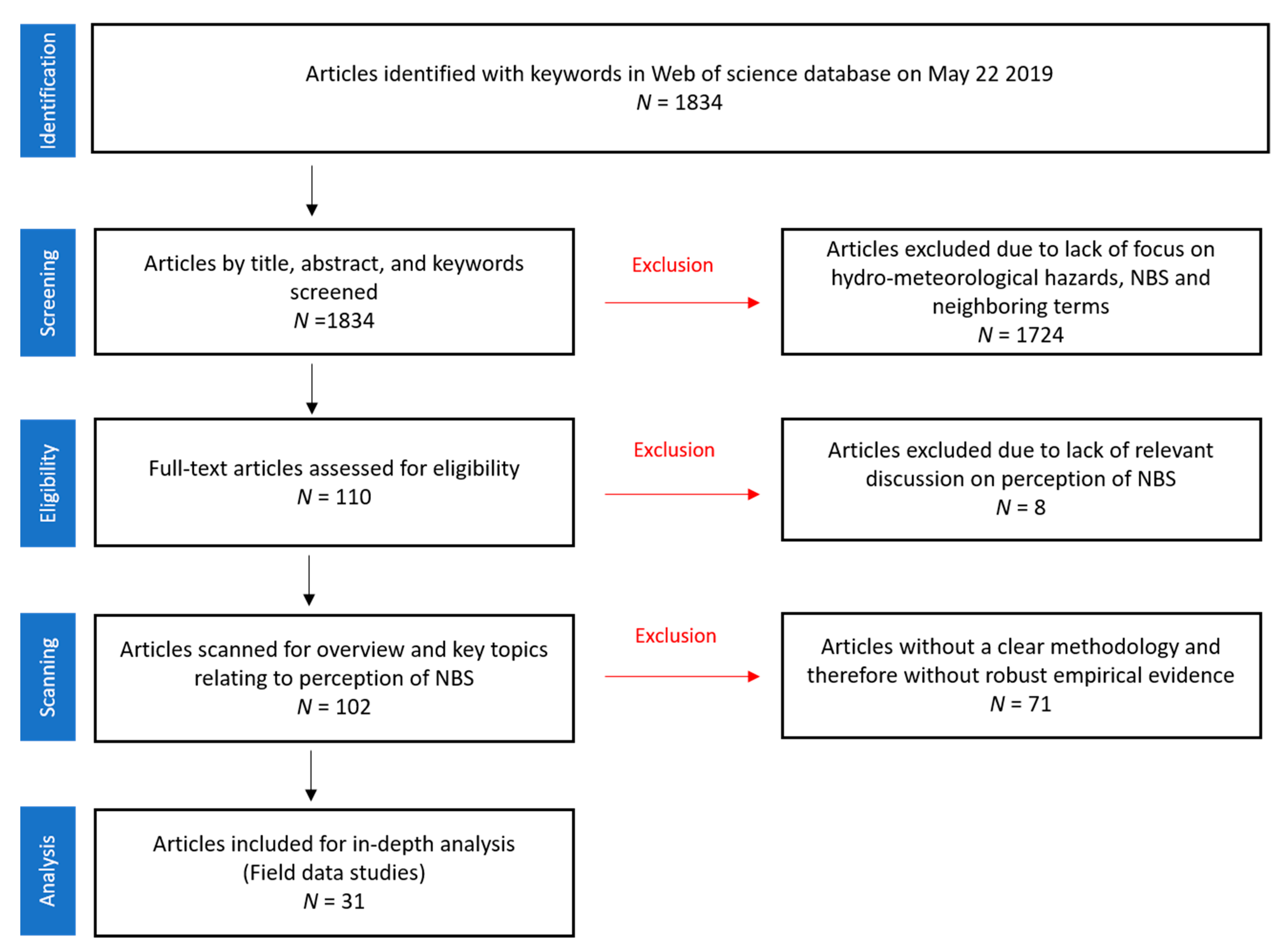
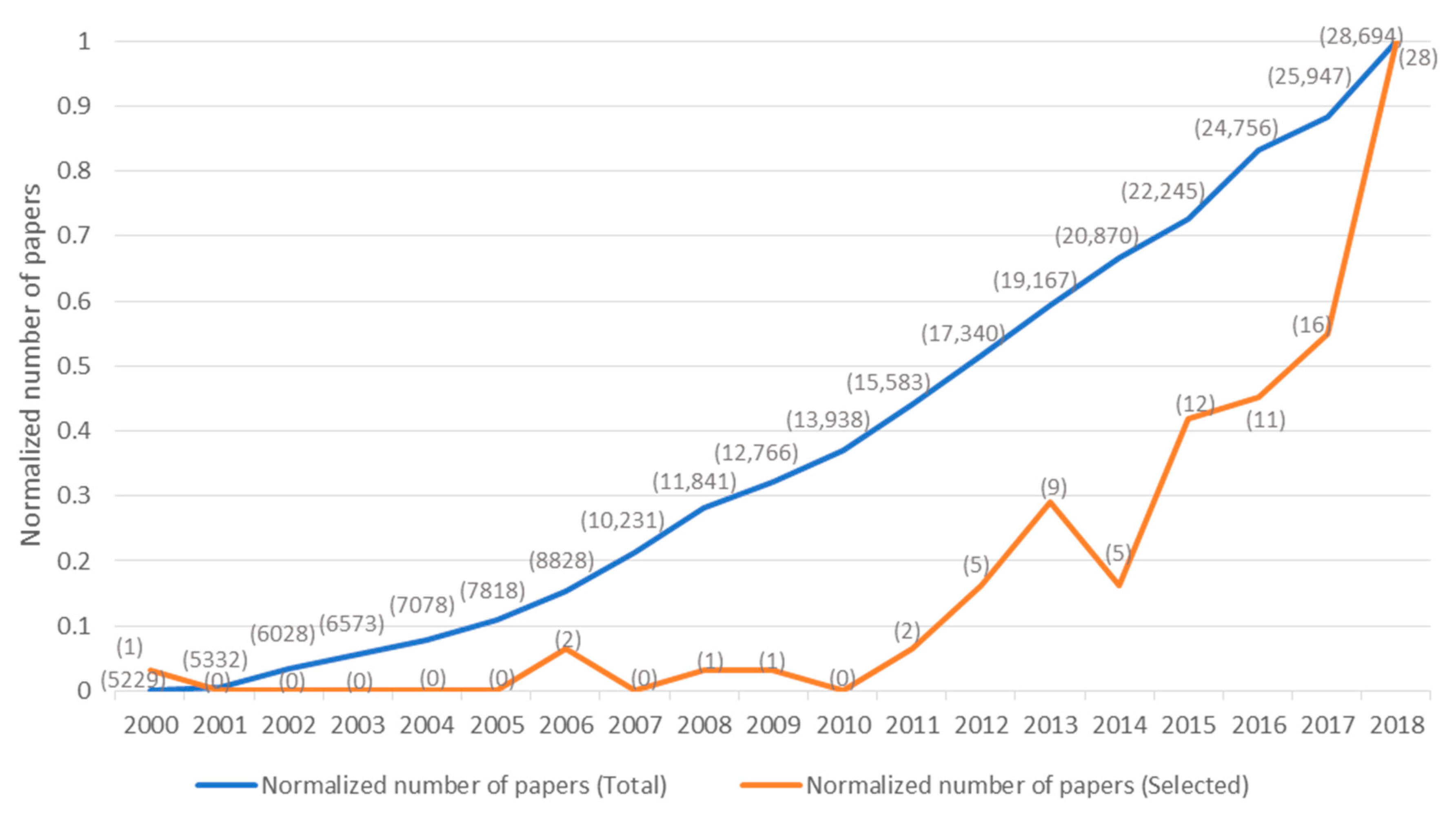
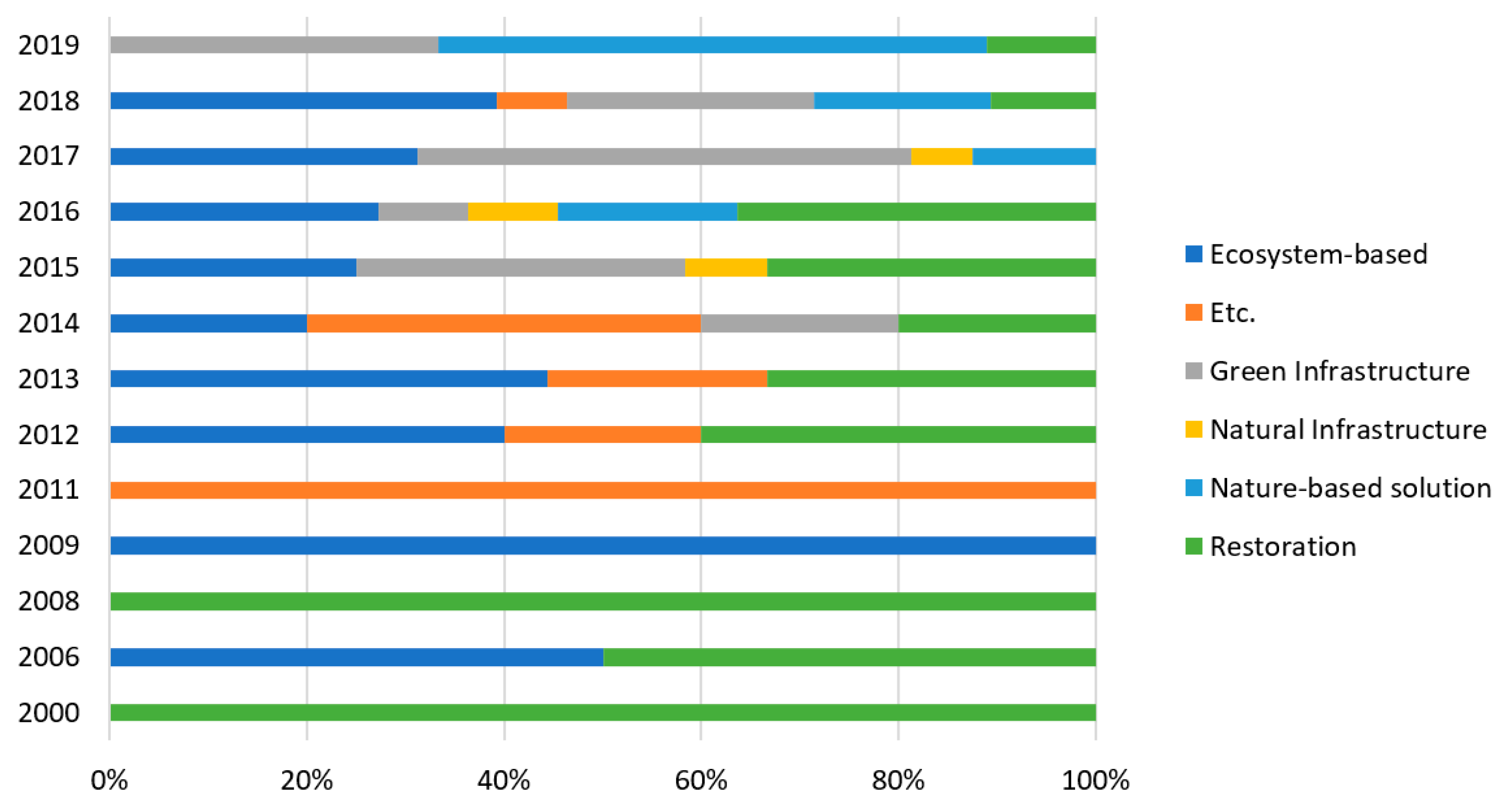
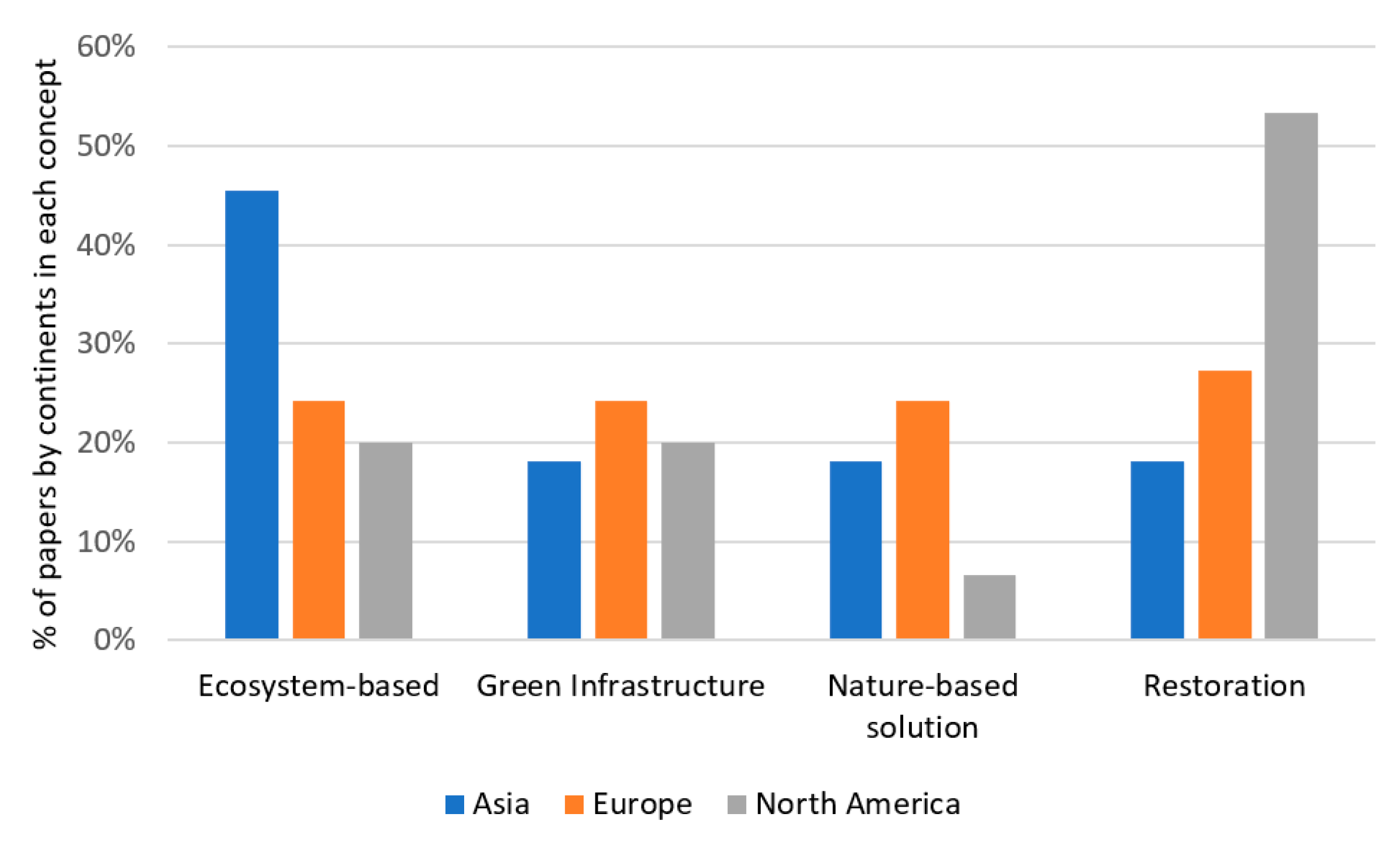
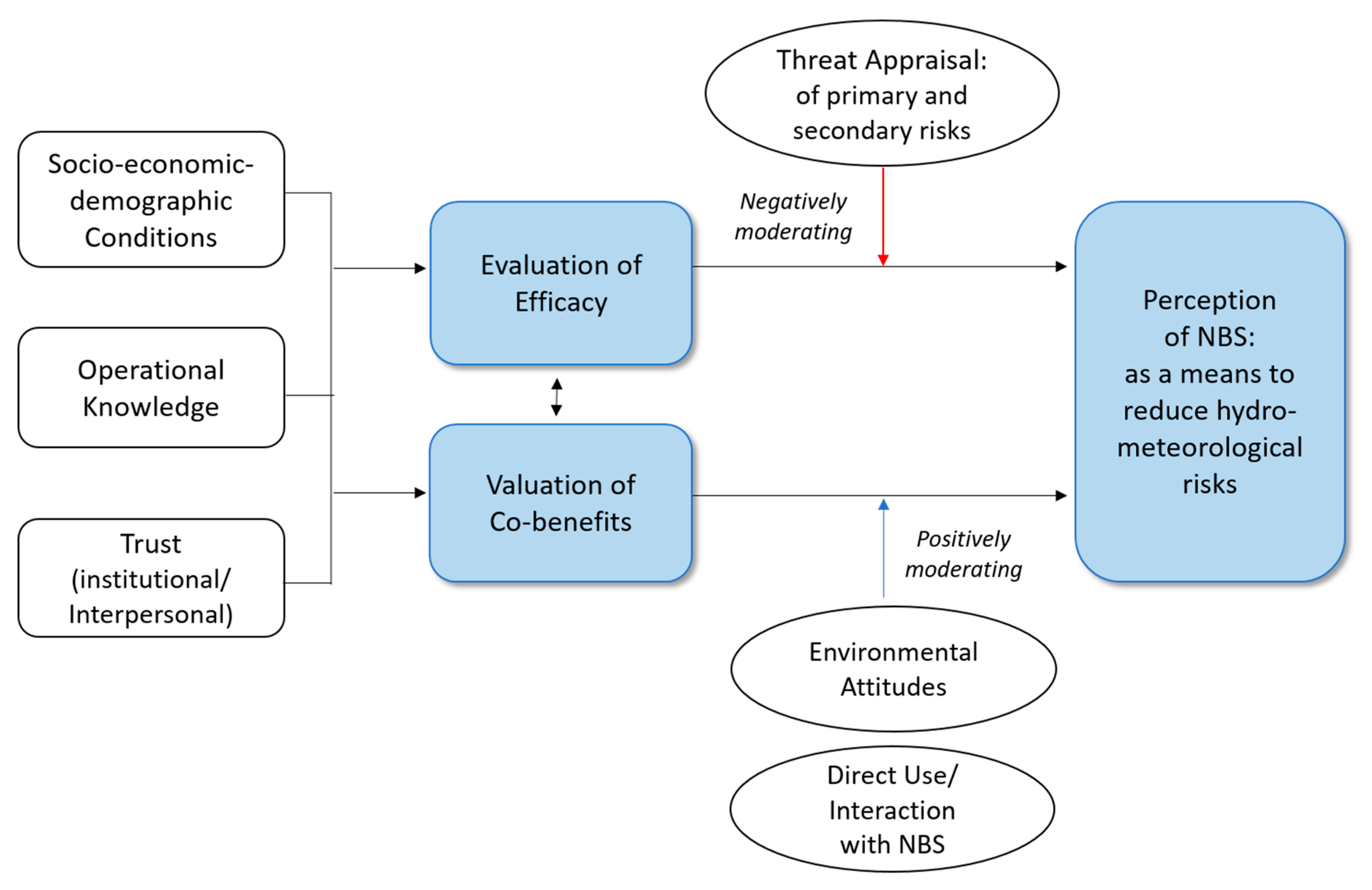
| Ecosystem-Based Approach | Restoration Technology/Engineering Approach | Infrastructure-Related Approach | ||
|---|---|---|---|---|
| Concept (Main) | -Ecosystem-Based Adaptation | -River Restoration | -Ecological Engineering | -Green Infrastructure |
| Other concepts | -Ecosystem Services | -Ecological Restoration | -Hybrid Engineering | -Blue-Green Infrastructure |
| -Ecosystem Disaster Risk Reduction | -Ecosystem-service Restoration | -Natural Infrastructure | ||
| Definition | ‘use biodiversity and ecosystem services as part of an overall adaptation strategy to help people to adapt to the adverse effects of climate change.’ [57] | ‘re-establishment of natural physical processes (e.g., variation of flow and sediment movement), features (e.g., sediment sizes and river shape) and physical habitats of a river system (including submerged, bank and floodplain areas). … it promotes the idea of encouraging natural processes to create characteristic, self-sustaining, dynamic physical habitat that induces biological recovery and restores the benefits humans rely on.’ [58] | ‘the design of sustainable ecosystems that integrate human society with its natural environment for the benefit of both’ [59] ‘actions using and/or acting for nature’ [60] ‘...can stand alone, but can also be incorporated into hybrid engineering solutions, where ecosystems are utilized alongside engineered defenses.’ [53] | ‘an interconnected network of natural areas and other open spaces that conserves natural ecosystem values and functions, sustains clean air and water, and provides a wide array of benefits to people and wildlife.’ [61] ‘...is a strategically planned network of natural and semi-natural areas with other environmental features designed and managed to deliver a wide range of ecosystem services. It incorporates green spaces (or blue if aquatic ecosystems are concerned) and other physical features in terrestrial (including coastal) and marine areas. On land, green infrastructure is present in rural and urban settings.’ [56] |
| Focus | Benefits that humans derive from biodiversity and ecosystem services, focus on tackling with climate change [23] | Ecosystem self-design and self-organization [62] | Connectivity, multifunctionality, and smart conservation [63] | |
| NBS and Related Concepts | Hydro-Meteorological Hazards | Key Themes |
|
|
|
| Search Terms | ||
| “Nature based solution*” OR (“Eco*system*” NEAR (solution OR management OR adaptation OR mitigation OR Approach OR Framework)) OR “Ecolog* Engineer*” OR “Catchment System Engineer*” OR “Ecolog* Restor*” OR “Green Infrastructur*” OR “Natur*Infrastructur*” OR (“Eco*hydro*” NEAR (solution OR management OR adaptation OR mitigation OR engineer)) OR “Adapt*service*” OR “Natural Capital” OR “River Restoration” | AND (pluv* OR coast* OR *meteo* OR hydro* OR flood* OR climate Change OR disaster OR natural OR environmental) AND (risk OR hazard) | AND (perce*) OR (aware*) OR (resilien*) OR (participat*) OR (stakeholder involv*) OR (governance) OR (vulnerab*) OR (trust) OR (planning) OR (policy) OR (accept*) OR (*cognit*) OR (prefer*) |
| Concepts | Number of Papers | Percent |
|---|---|---|
| Ecosystem-based | 31 | 30% |
| Eco-Disaster Risk Reduction | 4 | 4% |
| Ecosystem Approach | 1 | 1% |
| Ecosystem Services | 4 | 4% |
| Ecosystem-based Adaptation | 13 | 13% |
| Ecosystem-based Approach | 1 | 1% |
| Ecosystem-based DRR | 2 | 2% |
| Ecosystem-based Management | 5 | 5% |
| Ecosystem-based Solution | 1 | 1% |
| Green Infrastructure | 24 | 23% |
| Blue-Green Infrastructure | 3 | 3% |
| Green Infrastructure | 20 | 20% |
| Urban Green Infrastructure | 1 | 1% |
| Restoration | 21 | 21% |
| Ecological Restoration | 2 | 2% |
| Ecosystem Restoration | 1 | 1% |
| Ecosystem Services Restoration | 1 | 1% |
| Restoration | 2 | 2% |
| River Restoration | 14 | 14% |
| Stream Restoration | 1 | 1% |
| Nature-based solution | 14 | 30% |
| Etc. | 9 | 9% |
| Conservation | 1 | 1% |
| Flood Control Infrastructure | 1 | 1% |
| Hybrid Engineering | 2 | 2% |
| Integrated Catchment Management | 1 | 1% |
| Multi-functional Urban Watercourses | 1 | 1% |
| Planned Retreat | 1 | 1% |
| River Corridor Management | 1 | 1% |
| River Engineering, de-culverting | 1 | 1% |
| Natural Infrastructure | 3 | 3% |
| Natural and Nature-based Infrastructure | 1 | 1% |
| Natural Infrastructure | 1 | 1% |
| Nature-based Infrastructure | 1 | 1% |
| Total | 102 | 100% |
| Continent | # of Papers | Percent |
|---|---|---|
| Europe | 34 | 32% |
| North America | 19 | 18% |
| Asia | 13 | 12% |
| Africa | 4 | 4% |
| South America | 4 | 4% |
| Oceania | 3 | 3% |
| Global | 28 | 27% |
| Total | 105 1 | 100% |
| Topics | Key References | |
|---|---|---|
| (1) Valuation of co-benefits | ||
| • Valuation of benefits for ecosystem | [30,67,68,69,70] | |
| • Valuation of societal or other benefits | [20,30,31,71,72,73,74,75] | |
| (2) Evaluation of risk reduction efficacy | ||
| • Relevance of the physical presence and visibility of measures | [20,30,31,72,73,76,77,78] | |
| • Expectation towards the successful realization of NBS | [30,71,79] | |
| (3) Stakeholder participation | ||
| • Role of communication between stakeholders | [31,71,80,81,82,83] | |
| • Role of trust between stakeholders | [84,85,86] | |
| • Role of trust in institutions | [87] | |
| (4) Socio-economic and location-specific condition | ||
| • Individual economic conditions | [75,88] | |
| • Educational level | [33,74,89,90] | |
| • Location-specific conditions | [30,91,92,93,94] | |
| • Environmental justice and equity | [84,88] | |
| (5) Environmental Attitude | ||
| • Stewardship of nature | [74,91,93] | |
| (6) Uncertainty | ||
| • Time lag for observing benefits | [21,53,77,95,96] | |
| • Lack of data and knowledge | [30,53,84,91,94,97,98,99] | |
| • Uncertain conditions upon human-nature interactions | [21,100] | |
© 2019 by the authors. Licensee MDPI, Basel, Switzerland. This article is an open access article distributed under the terms and conditions of the Creative Commons Attribution (CC BY) license (http://creativecommons.org/licenses/by/4.0/).
Share and Cite
Han, S.; Kuhlicke, C. Reducing Hydro-Meteorological Risk by Nature-Based Solutions: What Do We Know about People’s Perceptions? Water 2019, 11, 2599. https://doi.org/10.3390/w11122599
Han S, Kuhlicke C. Reducing Hydro-Meteorological Risk by Nature-Based Solutions: What Do We Know about People’s Perceptions? Water. 2019; 11(12):2599. https://doi.org/10.3390/w11122599
Chicago/Turabian StyleHan, Sungju, and Christian Kuhlicke. 2019. "Reducing Hydro-Meteorological Risk by Nature-Based Solutions: What Do We Know about People’s Perceptions?" Water 11, no. 12: 2599. https://doi.org/10.3390/w11122599
APA StyleHan, S., & Kuhlicke, C. (2019). Reducing Hydro-Meteorological Risk by Nature-Based Solutions: What Do We Know about People’s Perceptions? Water, 11(12), 2599. https://doi.org/10.3390/w11122599





